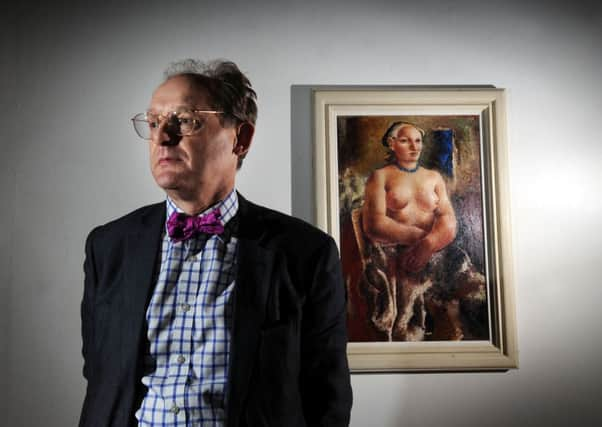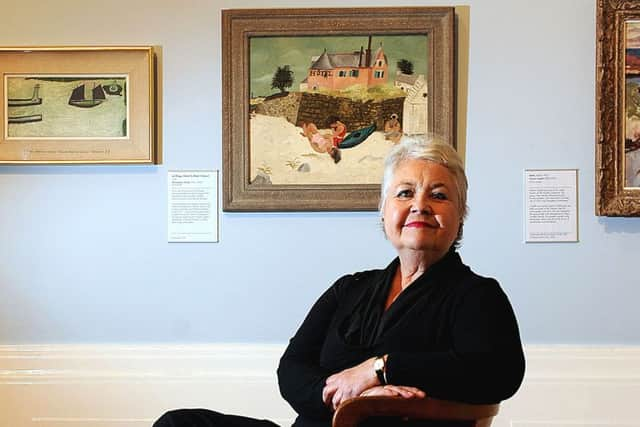Poetry of the soul


After 500 or so breathless words, Christopher Wood’s letter to his friend and fellow artist Winifred Nicholson suddenly peters out. “Excuse me,” he writes, “as Cocteau has arrived to see me.”
It was a Thursday in June 1927 and the 26-year-old Wood was having a lively time in Paris: painting, socialising, taking opium, hob-nobbing with the fashionable artistic set. He knew the impresario Diaghilev and the writer Andre Gide, Picasso lived next door, and he was perhaps a tad more than friendly with the great poet, novelist and film-maker Jean Cocteau.
Advertisement
Hide AdAdvertisement
Hide AdIt was all exhilaratingly busy, but there’s a great sadness here. Wood, who is being doubly celebrated in Yorkshire this autumn, with a new book and exhibition, had just three more years to live. After lunching with his mother and sister in August 1930, he threw himself under the Atlantic Coast Express at Salisbury railway station.


Wood, born at Knowsley near Liverpool and known to friends as Kit, was as colourful as his own pictures: his relationships included a Guinness heiress and a male Chilean diplomat. He is hardly a household name today, but a retrospective of his work in 1938 had 50,000 visitors. It drew on an astonishing output: 800 pictures in just 10 years. In the final, sometimes frenzied, years of his life, he was turning out two or three canvases a day. Some of the best of them – of fishing boats, harbour life, Cumberland landscapes, still lifes with vases, a startlingly surreal late image of a zebra and a parachutist – are on show at Leeds Art Gallery until next January as part of a major exhibition, called Art and Life. It features Wood alongside his friends Ben and Winifred Nicholson, the Cornish fisherman-painter Alfred Wallis and the potter William Staite Murray.
One Wood picture not on show, however, is La Plage, a curiously dream-like beach scene in Brittany: three women sunbathing in front of a turreted pink hotel, with a dark, brooding sky and, as in many of his pictures, a strange “stretched” perspective, as though viewed through a fish-eye lens.
It was this haunting canvas, held by Sheffield’s Graves Art Gallery and chosen as one of Yorkshire’s Favourite Pictures two years ago, that, back in the late 1970s, first alerted Anne Goodchild to the fascination of Wood’s life and work.
Advertisement
Hide AdAdvertisement
Hide AdShe had just arrived in Sheffield as assistant curator at the Graves, which had recently bought La Plage. “It made an immediate impact on me,” she says. “I didn’t know much about him, but I was sent to do some research on the painting, and I read his letters. I thought what an amazing man he was to do these works – and what extraordinary letters.
“I had an increasing admiration as I got to know his work; it’s lyrical but it’s intense. The pictures have a unique voice; there’s a great sense of poetry about them; it sounds pretentious but there’s the poetry of the soul in everything he did.”
Anne, who subsequently became senior curator with Sheffield Galleries and Museums Trust and still lives in the city as a freelance curator and writer, has paid a fine tribute to the artist with her newly-published Dear Winifred, an absorbing selection of his letters to the Nicholsons over the last four years of his life.
They give an alarming insight into his feverish working routine, his self-obsession – and all too often his demons. The sentences hurtle along, helter-skelter, often unimpeded by punctuation and with headlong handwriting that seems to have had no time for re-reading or correcting.
Advertisement
Hide AdAdvertisement
Hide AdAs the reader follows him from London to Paris to Brittany, there’s a grim awareness of just how quickly time is running out for him. He describes his “life and death struggle” with his work and says “I seem to live on the very edge of the world”.
He writes from Paris in 1927: “Everything is a maelstrom at the moment... I work at a terrific speed and force but at the same time in a sort of trance not knowing exactly what I am doing... Sometimes I work from 10 in the morning until five in the evening literally without stopping to look at what I am doing... this complete lack of sense of what is going on around me terrifies me.” A hint of opium sometimes seems to waft through the prose.
“If people know the name Christopher Wood, they get very excited when you mention him,” says Anne. “He could be a pain in the neck, he could be so self-indulgent and self-pitying, but he engendered the most passionate love and devotion, in both sexes.”
That devotion is clear from his replies to the Nicholsons’ letters (which don’t themselves survive). The relationship between the three painters – Winifred thought Wood “practically gave his life for those pictures” – is explored in the Leeds exhibition, which focuses on the years 1920 to 1931 and has been curated by Jovan Nicholson, Ben and Winifred’s grandson.
Advertisement
Hide AdAdvertisement
Hide Ad“It’s hard to talk about ‘Ben and Winifred Nicholson’ when they were your grandparents,” he says. “So I’ve had to detach myself emotionally from it and ask the usual art-historical questions: ‘Why was this picture of a farm painted?’ rather than thinking of it as, say, a farm I know well.”
He recalls Winifred saying she was “mystified” by Wood’s suicide. “She said they walked up the Champs-Elysees in 1930 and he said, ‘This is going to be my last spring.’ She said, ‘How could he say that?’ There was a great sense of foreboding about it.”
The exhibition offers a chance to compare the same Cumberland view interpreted by Wood and the two Nicholsons. And its fine catalogue includes two observations by Winifred that perhaps encapsulate Wood’s impact on the couple’s world and the tragedy of his wasted potential. “His vision is true, his grasp real, his power is life itself,” she wrote. “His arrival was like a meteor.”
Art and Life is at Leeds Art Gallery, to January 12. 0113 247 8256.
Advertisement
Hide AdAdvertisement
Hide AdDear Winifred..., edited by Anne Goodchild: Sansom & Company, £15. Anne Goodchild will be discussing the book at Sheffield’s Millennium Galleries on October 27, 0114 273 4400, and at Leeds Art Gallery on November 20.